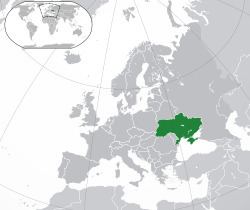Capital Kiev Founded 1991 | Preceded by Succeeded by | |
 | ||
Government Transitional government Today part of Ukraine Russia (disputed) | ||
The post-Soviet transition in Ukraine was established following the country's independence in 1991 up until the adoption of its constitution in 1996.
Contents
Geography
Ukraine's territory (including the Crimean Peninsula) was the same as that of the Ukrainian SSR with a land area of about 603,700 km2.
Independence
The Ukrainian Soviet Socialist Republic was one of the founding states of the Soviet Union (USSR). In 1985, Mikhail Gorbachev became head of state of the USSR and introduced a number of policies, such as the perestroika and glasnost. Instead of saving the Soviet regime, the reforms triggered a number of popular upheavals in Europe, such as the fall of the Berlin Wall in 1989.
Between 1990 and 1991, several republics of the Soviet Union proclaimed their state sovereignty and then announced their independence. On July 16, 1990, the Ukrainian SSR's parliament issued its 12th legislation proclaiming the sovereignty of Ukraine's territory and the country eventually declared its independence on August 24, 1991. The declaration was then confirmed by the results of the referendum on December 1 later that year, where 90,3 % of voters were in favor of independence. The same day, Leonid Kravchuk, head of the Supreme Council of Ukraine, was elected as the country's first president. Following his election, an economic then political crisis developed and Kravchuk organized another presidential election as a response.
End of the transitional period
In 1994, Leonid Kuchma was elected by 52% of the voters. He started implementing certain economic reforms paving the way for aid by the International Monetary Fund. However, Kuchma fails to obtain a majority in the following legislative election by parliament and had to share power with the opposition. The 13th legislation was issued by parliament on June 28, 1996, where a constitution was adopted and took effect immediately afterwards. The country's official name became "Ukraine" instead of "Republic of Ukraine".
